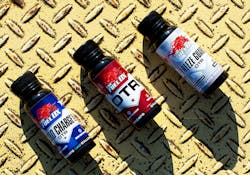You know how truckers sometimes rely on those little bottles from the gas station counters chock-full of caffeine and amino acids to keep them alert and efficient? They can do the same for their trucks’ engines by adding a 3 oz. bottle of Fuel Ox OTR fuel additive to the tank during a fill-up, which packs enough power to improve fuel efficiency by 4 to 8%, while lowering diesel particulate filer regenerations by two/thirds, according to Fuel Ox testing.
The highly concentrated formulation, originally developed for the military, treats up to 120 gallons of diesel or gasoline to stabilize the fuel, lubricate and clean engines, guard against corrosion and remove water. The liquid has the added benefit of cutting soot and particulates as well, therefore reducing the amount of greenhouse gases (GHGs) emitted.
“We’re introducing The Fuel Ox OTR with the needs of the long-haul trucker in mind,” said Rand Taylor, president of Fuel Ox LLC. “They want to reduce and contain their fuel costs, keep their engines running at optimal efficiency, spend as little downtime as possible as their DPFs regenerate, and get to the dock as safely and quickly as they can.”
Fuel OX OTR is available in all-season, Cold Charge and Freeze Guard formulas. The latter two have anti-gelling properties to lower the cold filter plugging point, the temperature at which diesel fuel becomes so thick and slushy that it can't pass through filters, which is around 5-10 degrees F. The Fuel Ox Cold Charge and Freeze Guard products reduce that plugging point by 33-42 degrees so the Cold Filter Plugging Point is somewhere in the range of -30 degrees F. The Cold Charge version includes a combustion catalyst, which points to the low temperature operability, from 75 degrees F to 42 degrees F.
One bottle costs $9.99 each or $7.50 when purchasing 25 or more. The low end of savings (4%) will save $9.60 per fill up for a truck with a 100-gallon fuel tank full of diesel at the current national price ($2.40). And there would be a little additive left over. For 120 gallon tanks, a driver would save $11.52 per fill-up, or about a $4 ROI if bought in bulk. That does not include total cost of ownership savings brought about by decreasing wear and tear on the engine, DPF and other associated systems.
The 3 oz bottles are easiest to store on the truck, though gallon jugs are available to treat 10,000 gallons of fuel and 55-gallon drums can be placed at filling stations and bulk terminals.





